 W
WThe shortnose sucker is a rare species of fish in the family Catostomidae, the suckers. This fish is native to southern Oregon and northern California in the United States. It is a federally listed endangered species of the United States.
 W
WThe June sucker is an endangered species of fish endemic to Utah Lake and the Provo River in the U.S. state of Utah. It is a gray or brownish fish with a paler belly, growing up to about 24 in (61 cm). It lives alongside the Utah sucker, which has a much wider range, and because the populations of both fish having been much reduced by fishing, other species such as the common carp have been introduced into the lake. As a result, the June sucker has become "critically endangered" as the pure species is lost as a result of hybridization with the Utah sucker, and predatory fish feed on its larvae. Conservation measures have been put in place and fish are being raised in a fish hatchery for reintroduction.
 W
WThe Chinese high-fin banded shark is a popular freshwater aquarium fish that belongs to the family Catostomidae. It grows to about 1.35 m long and is unsuitable for most home aquariums.
 W
WThe humpback chub is a federally protected fish that lived originally in fast waters of the Colorado River system in the United States. This species takes its name from the prominent hump between the head and dorsal fin, which is thought to direct the flow of water over the body and help maintain body position in the swift currents of the Colorado. The body is almost entirely scaleless, retaining only about 80 mid-lateral scales along the lateral line. The fish is very streamlined, with a thin caudal peduncle and a deeply forked tail. The back is a light olive gray, the sides silver, and the belly white. The dorsal fin usually has nine rays, and the anal fin 10 or more. Maximum recorded length is 38 cm.
 W
WThe Comanche Springs pupfish is a species of pupfish in the family Cyprinodontidae.
 W
WThe Death Valley pupfish, also known as Salt Creek pupfish, is a small species of fish in the family Cyprinodontidae found only in Death Valley National Park, California, United States. There are two recognized subspecies: C. s. salinus and C. s. milleri. The Death Valley pupfish is endemic to two small, isolated locations and currently classified as endangered.
 W
WThe Death Valley pupfish, also known as Salt Creek pupfish, is a small species of fish in the family Cyprinodontidae found only in Death Valley National Park, California, United States. There are two recognized subspecies: C. s. salinus and C. s. milleri. The Death Valley pupfish is endemic to two small, isolated locations and currently classified as endangered.
 W
WDanio margaritatus, the celestial pearl danio, often referred to in the aquarium trade as galaxy rasbora or Microrasbora sp. 'Galaxy', is a small cyprinid from Myanmar. It has so far been found only in a very small area near Hopong east of Inle Lake, at an altitude of over 1,000 m (3,400 ft). Its habitat is part of the Salween basin, namely the Nam Lang and Nam Pawn Rivers. Discovered in 2006, the species quickly appeared in the aquarium trade, where its small size and bright colours made it an instant hit.
 W
WThe Death Valley pupfish, also known as Salt Creek pupfish, is a small species of fish in the family Cyprinodontidae found only in Death Valley National Park, California, United States. There are two recognized subspecies: C. s. salinus and C. s. milleri. The Death Valley pupfish is endemic to two small, isolated locations and currently classified as endangered.
 W
WThe Lost River sucker is a species of ray-finned fish in the family Catostomidae. It is the only living member of the genus Deltistes. It is found only in California and Oregon. Its population is much reduced from historical numbers for a number of reasons. It is a federally listed endangered species of the United States. This species is known as the C'waam by the local Native American Nation, the Klamath Tribes.
 W
WThe Japanese eel is a species of anguillid eel found in Japan, Korea, China, Taiwan, and Vietnam, as well as the northern Philippines. Like all the eels of the genus Anguilla and the family Anguillidae, it is catadromous, meaning it spawns in the sea, but lives parts of its life in fresh water. The spawning area of this species is in the North Equatorial Current in the western North Pacific to the west of the Mariana Islands. The larvae are called leptocephali and are carried westward by the North Equatorial Current and then northward by the Kuroshio Current to East Asia, where they live in rivers, lakes, and estuaries. The Japanese eel is an important food fish in East Asia, where it is raised in aquaculture ponds in most countries in the region. In Japan, where they are called unagi, they are an important part of the food culture, with many restaurants serving grilled eel, which is called kabayaki.
 W
WHypselobarbus is a genus of fish in the family Cyprinidae endemic to India.
 W
WThe June sucker is an endangered species of fish endemic to Utah Lake and the Provo River in the U.S. state of Utah. It is a gray or brownish fish with a paler belly, growing up to about 24 in (61 cm). It lives alongside the Utah sucker, which has a much wider range, and because the populations of both fish having been much reduced by fishing, other species such as the common carp have been introduced into the lake. As a result, the June sucker has become "critically endangered" as the pure species is lost as a result of hybridization with the Utah sucker, and predatory fish feed on its larvae. Conservation measures have been put in place and fish are being raised in a fish hatchery for reintroduction.
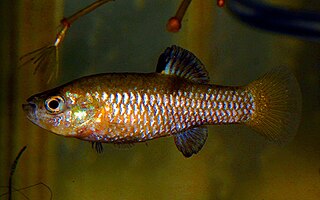 W
WThe Cuatro Ciénegas killifish is a critically endangered species of fish in the family Cyprinodontidae. It is endemic to Cuatro Ciénegas in Mexico.
 W
WThe Little Kern golden trout is a brightly colored subspecies of rainbow trout native to the main stem and tributaries of the Little Kern River in Tulare County, California. Together with the California golden trout and the Kern River rainbow trout, the Little Kern golden trout forms what is sometimes referred to as the "golden trout complex" of the Kern River basin.
 W
WThe loach minnow is a species of freshwater fish. It is a member of the carp family of order Cypriniformes. It occurs in streams and small rivers throughout the Gila River and San Pedro River systems in Arizona, New Mexico, and Sonora; it is now considered extinct in Mexico.
 W
WThe Minckley's cichlid is a species of fish in the family Cichlidae. It is endemic to Cuatro Ciénegas in Coahuila, Mexico. The specific name honours the ichthyologist Wendell L. Minckley (1935-2001) of Arizona State University who studied the ecology of Cuatro Ciénegas.
 W
WThe sheepshead minnow or sheepshead pupfish is a species of ray-finned fish in the family Cyprinodontidae, the pupfishes. It is found in salt marsh and estuary environments and is native to the eastern coasts of North and Central America.
 W
WThe Minckley's cichlid is a species of fish in the family Cichlidae. It is endemic to Cuatro Ciénegas in Coahuila, Mexico. The specific name honours the ichthyologist Wendell L. Minckley (1935-2001) of Arizona State University who studied the ecology of Cuatro Ciénegas.
 W
WThe Neosho madtom is a small North American freshwater catfish. It has been listed as a near-threatened species in the United States since 1996.
 W
WThe northern wolffish, or rock turbot, is a large marine fish of the family Anarhichadidae, native to the North Atlantic Ocean and Arctic Ocean. Other common names include the bull-headed catfish, blue catfish, broad-headed catfish, jelly wolffish, and the Arctic wolffish. Inuit in the Western Arctic do not distinguish between the northern wolffish and the Bering wolffish, calling both by the name akoak or akoaksaluk.
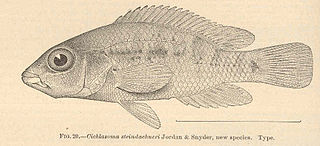 W
WNosferatu steindachneri, Steindachner's cichlid, is a species of cichlid endemic to Mexico where it is found in the Tamasopo, Gallinas and Ojo Frio Rivers of the Panuco River basin. It reaches a maximum size of 40.0 centimetres (15.7 in) SL. This species can also be found in the aquarium trade. The specific name honours the Austrian ichthyologist Franz Steindachner (1834-1919).
 W
WThe Owens tui chub was described in 1973 as a subspecies of tui chub endemic to the Owens River Basin in Eastern California, United States. The Owens tui chub is distinguished from its closest relative, the Lahontan tui chub, by scales with a weakly developed or absent basal shield, 13 to 29 lateral and apical radii, also by the structure of its pharyngeal arches, the number of anal fin rays, 10 to 14 gill rakers, and 52 to 58 lateral line scales. Dorsal and lateral coloration varies from bronze to dusky green, grading to silver or white on the belly. It may reach a total length of 30 centimetres (12 in). Owens tui chub are believed to be derived from Lahontan Basin tui chub that entered the Owens Basin from the north during the Pleistocene Epoch.
 W
WCuatro Cienegas pupfish is a species of fish in the Cyprinodon genus of the family Cyprinodontidae.
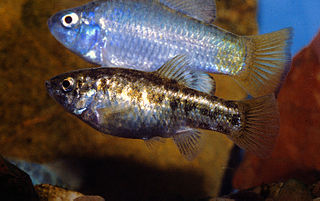 W
WThe desert pupfish is a rare species of bony fish in the family Cyprinodontidae. It is a small fish, typically less than 7.62 cm (3 in) in length. Males are generally larger than females, and have bright-blue coloration, while females and juveniles are silvery or tan. A notable attribute of the desert pupfish is their ability to survive in environments of extreme salinity, pH, and temperature, and low oxygen content. The desert pupfish mates in a characteristic fashion, wherein compatible males and females will contact each other, form an s-shape, and jerk. Each jerk typically produces a single egg that is fertilized by the male and deposited in his territory. Breeding behavior includes aggressive arena-breeding and more docile consort-pair breeding.
 W
WThreatened rays are those vulnerable to endangerment (extinction) in the near future. The International Union for Conservation of Nature (IUCN) is the world's oldest global environmental organisation. It evaluates threatened species, and treats threatened species not as a single category, but as a group of three categories, depending on the degree to which they are threatened: Vulnerable species Endangered species Critically endangered species
 W
WThe relict splitfin is a species of splitfin endemic to the Pánuco River system in Mexico. It feeds on algae. This species grows to 6 centimetres (2.4 in) in length. It is found in the aquarium trade. It is the only known member of its genus.
 W
WThe speartooth shark is an extremely rare species of river shark, belonging to the family Carcharhinidae. It inhabits coastal marine waters and tidal reaches of large tropical rivers in northern Australia and New Guinea. Despite being a member of the river shark genus, it is also found in near-shore marine waters, favoring highly turbid environments over a wide range of salinities. This robustly built, gray-colored shark is characterized by a short and broad snout, tiny eyes, a relatively large second dorsal fin, and a black blotch beneath each pectoral fin near the tip. Another identifying trait is its teeth, which are large, triangular, and serrated in the upper jaw and narrow, spear-like, and serrated only near the tips in the lower jaw. Adults grow to about 2.6 m (8.5 ft) long.
 W
WThe zebra shark is a species of carpet shark and the sole member of the family Stegostomatidae. It is found throughout the tropical Indo-Pacific, frequenting coral reefs and sandy flats to a depth of 62 m (203 ft). Adult zebra sharks are distinctive in appearance, with five longitudinal ridges on a cylindrical body, a low caudal fin comprising nearly half the total length, and usually a pattern of dark spots on a pale background. Young zebra sharks under 50–90 cm (20–35 in) long have a completely different pattern, consisting of light vertical stripes on a brown background, and lack the ridges. This species attains a length of 2.5 m (8.2 ft).
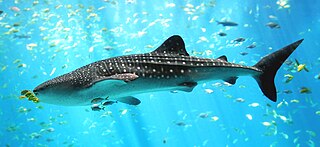 W
WThreatened sharks are those vulnerable to endangerment (extinction) in the near future. The International Union for Conservation of Nature (IUCN) is the world's oldest global environmental organization. It evaluates threatened species, and treats threatened species not as a single category, but as a group of three categories, depending on the degree to which they are threatened: Vulnerable species Endangered species Critically endangered species
 W
WThe shortnose sucker is a rare species of fish in the family Catostomidae, the suckers. This fish is native to southern Oregon and northern California in the United States. It is a federally listed endangered species of the United States.
 W
WThe common skate, also known as the blue skate, is the largest skate in the world, attaining a length of up to 2.85 m (9.4 ft). Historically, it was one of the most abundant skates in the northeast Atlantic Ocean and the Mediterranean Sea. Despite its name, today it appears to be absent from much of this range. Where previously abundant, fisheries directly targeted this skate and elsewhere it is caught incidentally as bycatch. The species was uplisted to critically endangered on the IUCN Red List in 2006 and it is protected within the EU.
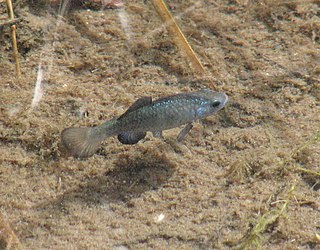 W
WThe Sonoyta pupfish or Quitobaquito pupfish is an endangered species of pupfish from Sonora in Mexico and Arizona in the United States.
 W
WThe spotted wolffish, also known as the leopardfish, is a large marine fish of the family Anarhichadidae. This bottom-dwelling species is found across the North Atlantic and adjacent parts of the Arctic Ocean from north of Russia and the Scandinavian Peninsula to the Scotian Shelf, off Nova Scotia, Canada. In Canada the population declined by about 90% from the late 1970s through the early 1990s, particularly in the northern part of its range. In Canada it is classified as a threatened species.
 W
WThe Lost River sucker is a species of ray-finned fish in the family Catostomidae. It is the only living member of the genus Deltistes. It is found only in California and Oregon. Its population is much reduced from historical numbers for a number of reasons. It is a federally listed endangered species of the United States. This species is known as the C'waam by the local Native American Nation, the Klamath Tribes.